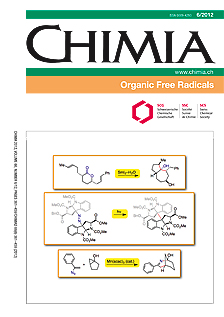Radical Carbon–Carbon Bond Formations Enabled by Visible Light Active Photocatalysts
DOI:
https://doi.org/10.2533/chimia.2012.394Keywords:
Carbon-carbon bond, Flow reactor, Photocatalysis, Radical, Visible lightAbstract
This mini-review highlights the Stephenson group's contribution to the field of photoredox catalysis with emphasis on carbon–carbon bond formation. The realization of photoredox mediated reductive dehalogenation initiated investigations toward both intra- and intermolecular coupling reactions. These reactions commenced via visible light-mediated reduction of activated halogens to give carbon-centered radicals that were subsequently involved in carbon–carbon bond forming transformations. The developed protocols using Ru and Ir based polypyridyl complexes as photoredox catalysts were further tuned to efficiently catalyze overall redox neutral atom transfer radical addition reactions. Most recently, a simplistic flow reactor technique has been utilized to affect a broad scope of photocatalytic transformations with significant enhancement in reaction efficiency.Downloads
Published
2012-06-27
Issue
Section
Scientific Articles
License
Copyright (c) 2012 Swiss Chemical Society

This work is licensed under a Creative Commons Attribution-NonCommercial 4.0 International License.
How to Cite
[1]
C.-J. Wallentin, J. D. Nguyen, C. R. J. Stephenson, Chimia 2012, 66, 394, DOI: 10.2533/chimia.2012.394.







